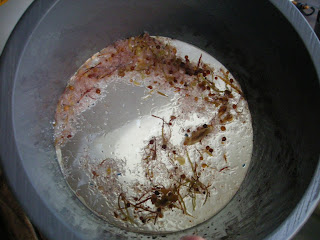 |
Nueston net.
|
The second net, called the Mini-Bongo (it looks just like its name) is made up of two connected PVC pipes that each have a net and cod end attached to them. One net has a mesh that captures the small stuff; the other has larger mesh that keeps in the bigger plankton. These samples will be used to examine what tuna are eating and to create a food web from stable isotope values of nitrogen.
The last net is the MOCNESS (also known affectionately as the MOCNESS Monster or the Franken-MOCNESS). This net can be really useful, as it has a unique system where plankton samples from different depths can be taken on a single tow by opening and closing various nets. It's taken us many hours to set it up and the system is very heavy, complicated, and had some set-up issues in the beginning, but in the last few days we've finally gotten it working and have done several successful MOC tows. If you're interested in learning more about the MOCNESS, visit WHOI's page.
And in case you're wondering (I bet you are!), MOCNESS stands for Multiple Opening and Closing Net Environmental Sensing System.
And in case you're wondering (I bet you are!), MOCNESS stands for Multiple Opening and Closing Net Environmental Sensing System.
 |
Mini-bongo, with two nets attached to
the "bongo" portion.
|
 |
| Diagram of the MOCNESS as it flies in the water |
 |
| Plankton collected in a sieve after a subsurface neuston tow |
No comments:
Post a Comment